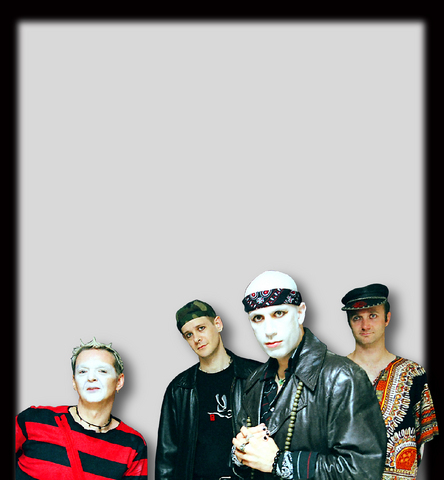If you want to treat yourself to the hardest rockin' band in Taipei, don't miss Sky Burial on Sunday from 9pm to 10pm at the Riverside Cafe.
Named after Tibetan funeral rites, the band is made up of seasoned musicians that hail from Chicago, New York, Maine and the UK.
They describe their music as Goth punk, Western, country, gospel, "Bright, happy stuff, SUV-driving [stuff] Americans listen to.''

Now they plan on "attacking the college crowd in Gongguan,'' according to lead singer Jimmy Vulture (aka Lance Gura).
Sky Burial started out in 2000 with what guitarist Brian Kleinsmith described as a "Hootenanny,'' a rural American jam session of U2, Beatles, old blues tunes.
The band of English teachers soon began writing their own songs, often recording in Kleinsmith's bathroom and laying down tracks with Kleinsmith's Bostex.
Gura and Kleinsmith found a formula: Gura writes lyrics, Kleinsmith works out the melody, and then Paul "Alfie'' Routledge and John Ring lay down drum and bass lines.
"We play roles and it works quite well,'' Routledge said.
Gura added, "It only takes Brian a few minutes to work it all out and to be on the same page. It makes me lick my lips to think of writing 10 more songs. In New York, it could be tedious.''
For the past year, Sky Burial has been perfecting its darkly satirical, hard-hitting punk style at the Living Room. With the help of hairdresser/Web master/drummer Routledge, they've incorporated a "bird of prey'' theme into their act and Web site (www.sky-burial.com), as well as projecting multimedia "eye candy'' behind them as they perform. Their upcoming album, The Freak at the End of the Rainbow, is due early next year.
With classic punk- and rock-inspired, tight riffs by guitarist Kleinsmith and searing lyrics by charismatic lead singer Gura, songs like Ivy and Punishment Fuck will send chills down the spines of even the quietest audience, or at least make them want to get on their feet. As a finale, they do an obscure and loveable Rolling Stones tune, Cocksucker Blues.
As Gura said in an interview. "It's fun to freak out the audience. They strangely don't leave. People are rubberneckers. They see the trainwreck coming and definitely want to check it out.''
Riverside Cafe (

That US assistance was a model for Taiwan’s spectacular development success was early recognized by policymakers and analysts. In a report to the US Congress for the fiscal year 1962, former President John F. Kennedy noted Taiwan’s “rapid economic growth,” was “producing a substantial net gain in living.” Kennedy had a stake in Taiwan’s achievements and the US’ official development assistance (ODA) in general: In September 1961, his entreaty to make the 1960s a “decade of development,” and an accompanying proposal for dedicated legislation to this end, had been formalized by congressional passage of the Foreign Assistance Act. Two

Despite the intense sunshine, we were hardly breaking a sweat as we cruised along the flat, dedicated bike lane, well protected from the heat by a canopy of trees. The electric assist on the bikes likely made a difference, too. Far removed from the bustle and noise of the Taichung traffic, we admired the serene rural scenery, making our way over rivers, alongside rice paddies and through pear orchards. Our route for the day covered two bike paths that connect in Fengyuan District (豐原) and are best done together. The Hou-Feng Bike Path (后豐鐵馬道) runs southward from Houli District (后里) while the

March 31 to April 6 On May 13, 1950, National Taiwan University Hospital otolaryngologist Su You-peng (蘇友鵬) was summoned to the director’s office. He thought someone had complained about him practicing the violin at night, but when he entered the room, he knew something was terribly wrong. He saw several burly men who appeared to be government secret agents, and three other resident doctors: internist Hsu Chiang (許強), dermatologist Hu Pao-chen (胡寶珍) and ophthalmologist Hu Hsin-lin (胡鑫麟). They were handcuffed, herded onto two jeeps and taken to the Secrecy Bureau (保密局) for questioning. Su was still in his doctor’s robes at

Mirror mirror on the wall, what’s the fairest Disney live-action remake of them all? Wait, mirror. Hold on a second. Maybe choosing from the likes of Alice in Wonderland (2010), Mulan (2020) and The Lion King (2019) isn’t such a good idea. Mirror, on second thought, what’s on Netflix? Even the most devoted fans would have to acknowledge that these have not been the most illustrious illustrations of Disney magic. At their best (Pete’s Dragon? Cinderella?) they breathe life into old classics that could use a little updating. At their worst, well, blue Will Smith. Given the rapacious rate of remakes in modern